Woodworking is a fantastic activity for children, offering numerous benefits that go beyond just building things with their hands. It provides an opportunity for children to explore their creativity, develop practical skills, and foster personal growth. Engaging in woodworking projects allows children to work with real tools, natural materials, and develop their strength and coordination. It stimulates their imagination and encourages critical thinking and problem-solving skills. Moreover, woodworking promotes self-esteem and a sense of agency in children, empowering them to take on new challenges and build confidence.
- Woodworking enhances creativity, practical skills, and personal growth in children.
- Working with real tools and natural materials in woodworking projects stimulates imagination and coordination.
- Woodworking fosters critical thinking, problem-solving skills, and builds confidence in children.
- It provides an authentic, hands-on experience that breaks away from the digital world.
- Implementing safety measures ensures woodworking is a low-risk activity for children.
Boosting Practical Skills and Independence
Woodworking activities for children provide a wonderful opportunity for them to develop practical skills and gain a sense of independence. Engaging in hands-on woodworking projects allows children to learn and apply various skills that are essential for their overall development.
Through woodworking, children develop fine motor skills as they manipulate tools and materials, enhancing their hand-eye coordination and dexterity. They learn to handle real tools responsibly and safely, cultivating a sense of responsibility and independence. Woodworking projects also provide a space for children to explore their creativity and imagination, allowing them to express themselves through their own unique creations.
Furthermore, woodworking encourages critical thinking and problem-solving skills. As children plan and execute their woodworking projects, they encounter challenges that require them to think critically and come up with creative solutions. They learn to analyze the dimensions of their project, measure and cut accurately, and troubleshoot any issues that may arise along the way. These problem-solving skills are transferable to various areas of their lives, fostering their overall cognitive development.
Cultivating skills through woodworking activities:
| Skill | Description |
|---|---|
| Hand-eye coordination | Manipulating tools and materials |
| Fine motor skills | Handling small objects and tools |
| Responsibility | Using tools safely and responsibly |
| Creativity | Expressing ideas through unique creations |
| Critical thinking | Planning, problem-solving, and troubleshooting |
By embracing woodworking activities, parents and educators empower children to grow as independent thinkers and problem solvers. The hands-on nature of woodworking fosters a sense of accomplishment and self-confidence, as children witness the tangible results of their efforts. This boost in confidence further encourages them to explore and pursue their interests, helping them develop a lifelong love for learning and an appreciation for the STEAM subjects.
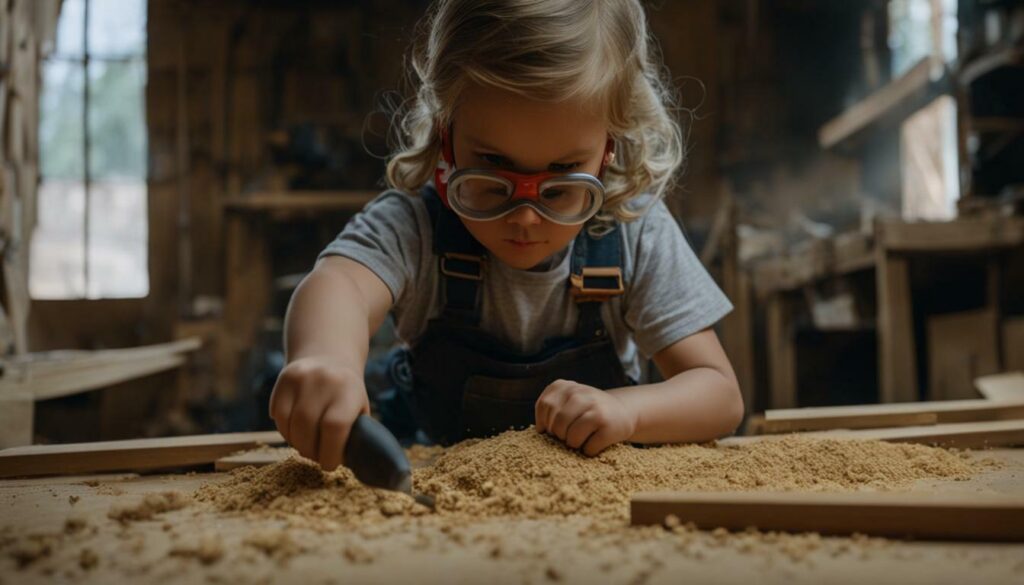
Woodworking is an engaging activity that brings together the mind and hands of children, encouraging them to think imaginatively and problem-solve as they create with wood. It provides a unique opportunity for children to explore their creativity and develop their artistic abilities. Working with real tools and materials gives children a sense of authenticity and accomplishment, as they see their ideas come to life.
Woodworking projects for kids promote hands-on learning, allowing children to actively participate in the creation process. As they measure, cut, and assemble pieces of wood, they are developing their fine motor skills and hand-eye coordination. These practical skills not only enable them to complete woodworking projects but also transfer to other areas of their lives, such as writing, drawing, and playing musical instruments.
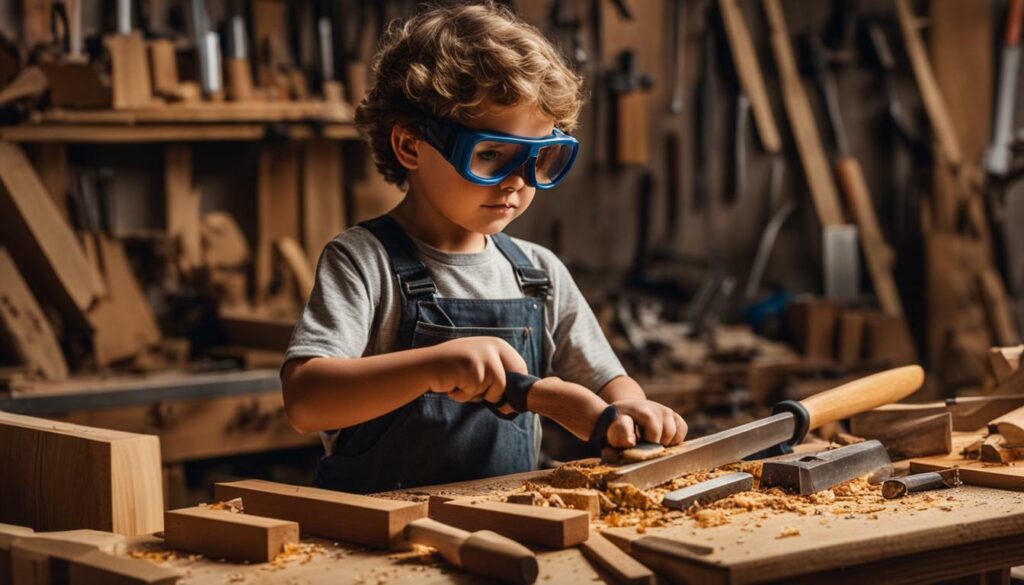
| Benefits of Woodworking for Kids | Promotes Creativity | Enhances Problem-Solving Skills |
|---|---|---|
| Woodworking allows children to express their ideas and explore their imagination. They can create unique pieces of art, furniture, or toys, giving them a sense of pride in their accomplishments. | Working with wood requires children to problem-solve and find solutions when faced with challenges. They learn to analyze and assess situations, fostering critical thinking skills. | |
| Develops Fine Motor Skills | Fosters Self-Esteem and Confidence | |
| Using tools and manipulating wood helps children develop their hand coordination and dexterity. This contributes to the refinement of their fine motor skills. | Completing woodworking projects boosts a child’s self-esteem and confidence as they see the tangible results of their efforts. They gain a sense of accomplishment and belief in their abilities. |
Woodworking is a valuable tool in promoting creativity through hands-on experiences. By engaging the mind and hands, children can gain a deeper understanding of the world around them while also building essential life skills. Encouraging children to embrace woodworking as a means of expression and problem-solving can have a profound impact on their overall growth and development.
Fostering Creativity and Imagination
Woodworking provides a platform for children to unleash their creativity and imagination, allowing them to explore their artistic talents and bring their ideas to life. Working with real tools and natural materials like wood engages their interest and encourages them to think outside the box. Through woodworking projects, children have the freedom to design and build their own creations, whether it’s a simple birdhouse or a more elaborate piece of furniture.
“Woodworking gives kids the opportunity to create something tangible from their own imagination. It’s a process of turning raw materials into something meaningful and unique. This hands-on experience allows children to express themselves, experiment with different techniques, and learn from their own mistakes.” – John Smith, Woodworking Educator
By engaging in woodworking, children develop problem-solving skills as they encounter challenges along the way. They learn to think critically, make decisions, and overcome obstacles that arise during the construction process. This encourages them to approach problems from different angles and explore innovative solutions.
Table: Woodworking Project Ideas for Kids
| Project | Description |
|---|---|
| Wooden Toy Cars | Children can design and build their own toy cars using small wooden blocks, wheels, and axles. |
| Birdhouses | Building birdhouses helps children develop their woodworking skills while creating a home for our feathered friends. |
| Picture Frames | Children can customize their own picture frames using wood, paints, and decorative elements. |
| Jewelry Boxes | Creating personalized jewelry boxes allows children to showcase their craftsmanship and creativity. |
Woodworking nurtures children’s self-esteem and sense of accomplishment. As they complete woodworking projects, they gain confidence in their abilities and take pride in their creations. This positive reinforcement encourages them to explore new ideas and challenges, paving the way for lifelong learning and growth.

Woodworking provides children with authentic, hands-on experiences that serve as a refreshing break from the digital world. It allows them to connect with nature, learn about the properties of different types of wood, and develop a deeper appreciation for craftsmanship. Through woodworking, children can create meaningful connections between their own work and the world around them, fostering a sense of wonder and curiosity.
Developing Critical Thinking and Problem-Solving Skills
Introducing woodworking to kids can have a significant impact on their critical thinking and problem-solving abilities, as they navigate the challenges and intricacies of working with wood. Woodworking is a hands-on activity that requires children to think critically, analyze situations, and find creative solutions to problems that may arise.
When children engage in woodworking projects, they are faced with tasks that require planning, measurement, and precision. They must determine the best approach to achieve their desired outcome, adapting and adjusting their strategies along the way. This process encourages them to think critically and consider different possibilities, fostering their problem-solving skills.
Woodworking provides children with opportunities to tackle complex tasks, overcome obstacles, and develop resilience. As they encounter setbacks and obstacles during their woodworking journey, they learn the importance of perseverance and the value of finding solutions to problems.
In addition to problem-solving, woodworking also nurtures critical thinking skills. Children must analyze their materials, consider their design choices, and evaluate the effectiveness of their techniques. This helps them develop a keen eye for detail, the ability to think logically, and the capacity to make informed decisions.
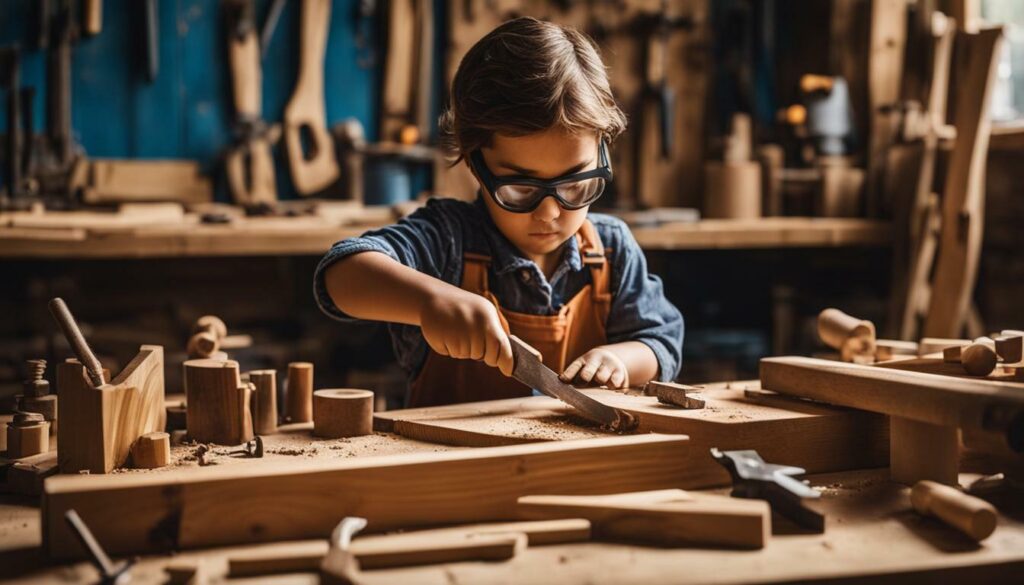
Woodworking projects allow children to exercise their cognitive abilities in a hands-on, practical way. Through the process of designing, measuring, cutting, and assembling wood, children engage their minds and develop critical thinking and problem-solving skills that go beyond the workshop. These skills will prove invaluable as they progress through their educational journey and life beyond the classroom.
Benefits of Introducing Woodworking to Kids
- Enhances critical thinking and problem-solving abilities
- Promotes creativity and imagination
- Fosters resilience and perseverance
- Develops practical skills and coordination
- Encourages self-expression and artistic abilities
By embracing woodworking as a tool for learning, parents and educators can provide children with a platform for holistic development. It not only stimulates their cognitive growth but also nurtures their confidence, independence, and sense of accomplishment. So, let’s grab some tools, unleash our creativity, and unlock the vast potential of woodworking for our kids!
| Key Takeaways: |
|---|
| Woodworking engages children’s critical thinking and problem-solving abilities as they navigate challenges and find solutions. |
| It fosters resilience, perseverance, and the ability to make informed decisions. |
| Woodworking promotes creativity, imagination, and the development of practical skills and coordination. |
Building Confidence and Self-Esteem
Woodworking is not only about creating physical objects; it also instills a sense of confidence and self-esteem in children as they see their ideas materialize into tangible results. When children engage in woodworking projects, they are empowered to take ownership of their work and develop a sense of accomplishment as they complete each task. This process cultivates a positive mindset, encouraging children to believe in their abilities and take pride in their achievements.
One of the advantages of woodworking for child growth is that it provides a platform for children to explore their creativity and imagination. With woodworking, children have the opportunity to transform a simple piece of wood into something unique and meaningful. As they experiment with different designs and techniques, they learn to think outside the box and embrace their own artistic vision. This fosters a sense of individuality and self-expression, boosting their confidence in their creative abilities.
Furthermore, woodworking promotes problem-solving skills and critical thinking in children. As they work with real tools and materials, they encounter challenges and obstacles that require them to think analytically and find practical solutions. Whether it’s measuring and cutting wood accurately or assembling pieces together, children develop a problem-solving mindset that can be applied to various aspects of their lives. This process enhances their cognitive abilities and equips them with valuable skills for future endeavors.
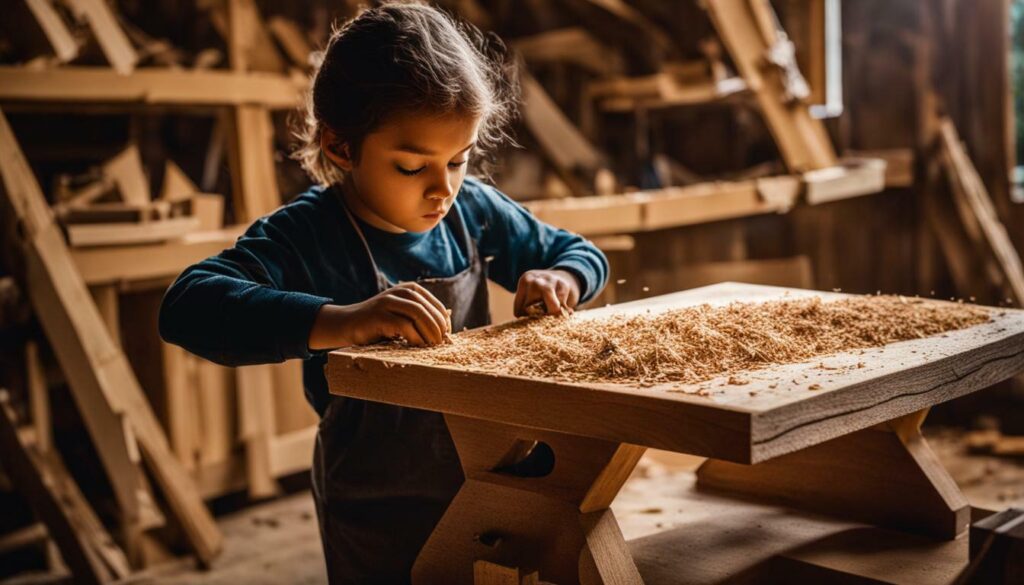
Testimonial:
“Woodworking has been a transformative experience for my child. Not only has it boosted their confidence, but it has also enhanced their problem-solving skills and nurtured their creativity. I can see the positive impact it has had on their overall growth and development. I would highly recommend woodworking to any parent or educator looking to empower children and provide them with valuable hands-on experiences.”
In conclusion, woodworking offers numerous advantages for child growth, including building confidence and self-esteem, promoting creativity and imagination, and fostering critical thinking and problem-solving skills. By incorporating woodworking into children’s lives, we can inspire and empower them to explore their potential, develop essential life skills, and embark on a lifelong journey of learning and self-discovery.
Embracing Authentic, Hands-On Experiences
In a world dominated by screens, woodworking projects offer children a chance to engage in tangible, hands-on experiences that are both meaningful and fulfilling. Working with real tools and materials, children can connect with the world around them in a way that digital media simply cannot replicate. Whether it’s shaping a piece of wood or assembling a project, woodworking allows children to experience the joy of creating something with their own hands.
Woodworking projects for kids provide a break from the virtual world, encouraging them to explore their creativity and develop essential skills. Through woodworking, children learn to plan, measure, and problem-solve, honing their critical thinking abilities. They are also exposed to basic principles of math and science as they work with measurements, weights, and forces. This hands-on approach gives children a solid foundation for lifelong learning, particularly in the STEAM disciplines of science, technology, engineering, arts, and mathematics.
“Woodworking helps kids develop not only practical skills, but also a sense of confidence and accomplishment. When they see their finished project, it instills a sense of pride and boosts their self-esteem.”
Woodworking projects also foster creativity and imagination, allowing children to express themselves through their work. Whether it’s building a birdhouse or carving a small sculpture, woodworking gives children the freedom to explore their artistic abilities. It encourages them to think outside the box, find unique solutions to design challenges, and showcase their individuality. This creative outlet nurtures their imagination and helps them develop a unique perspective on the world.
With proper safety measures in place, woodworking can be a low-risk activity for children. It is essential to provide close supervision, suitable tools, and teach children about safety procedures to ensure a safe woodworking environment. By adhering to these precautions, parents and educators can create a space where children can freely engage in woodworking projects and reap the numerous benefits that it offers.
| Benefits of Woodworking for Kids: |
|---|
| 1. Boosts practical skills and independence |
| 2. Engages the mind and hands |
| 3. Fosters creativity and imagination |
| 4. Develops critical thinking and problem-solving skills |
| 5. Builds confidence and self-esteem |
| 6. Provides authentic, hands-on experiences |
| 7. Promotes a low-risk activity with proper safety measures |
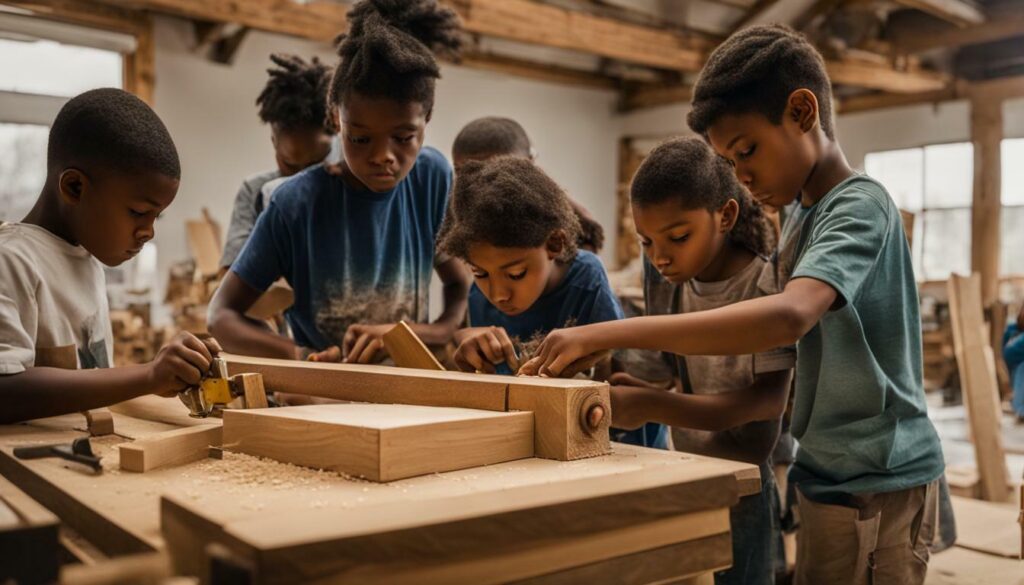
Woodworking projects for kids allow them to engage their curiosity, develop practical skills, and experience the satisfaction of creating something with their own hands. It is a holistic approach to education that promotes confidence, creativity, and critical thinking. By embracing woodworking as a valuable tool for children’s growth and development, parents and educators can provide them with authentic, hands-on experiences that will pave the way for a lifetime of learning and exploration.
Safety Measures and Low-Risk Activity
When proper safety measures are put in place, woodworking projects can provide a safe and enriching environment for children to learn and grow. It’s essential to prioritize safety to ensure that children can enjoy the benefits of woodworking without unnecessary risks.
One of the fundamental safety measures is closely supervising children during woodworking activities. This ensures that they are using tools and materials appropriately and avoids accidents or injuries. Providing clear instructions and demonstrating proper handling techniques are also essential in establishing a safe working environment.
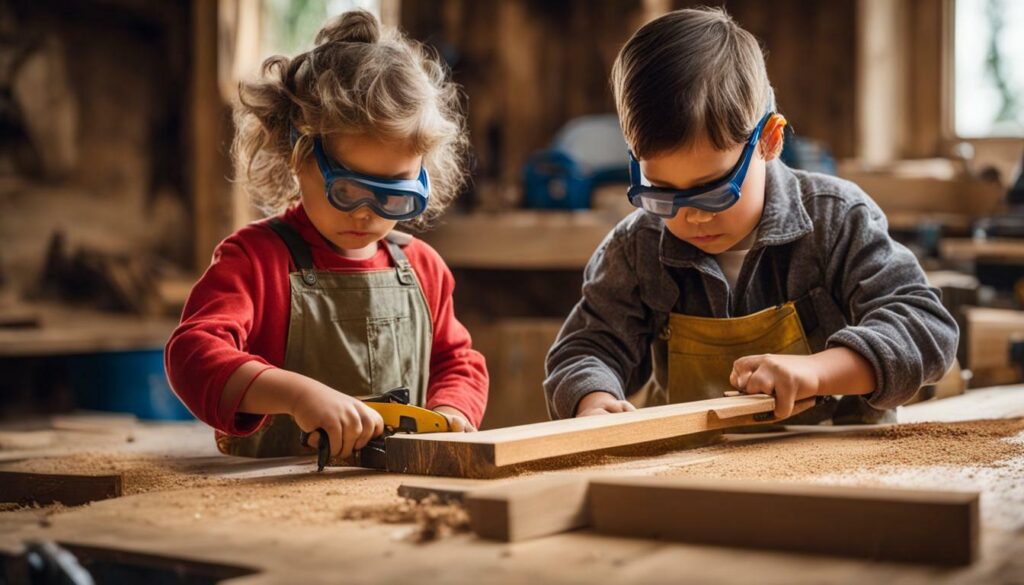
Another critical aspect of safety is using age-appropriate tools and equipment. Children should be given tools that are suitable for their age and abilities, ensuring that they can handle them effectively. By using tools designed for kids, the risk of accidents or injuries can be significantly reduced.
Woodworking Safety Tips for Kids:
- Always wear protective gear, such as safety goggles and gloves, when working with tools or handling wood.
- Work in a well-ventilated area to minimize exposure to dust and fumes.
- Keep fingers and hands away from the cutting edge of tools and blades.
- Keep the work area clean and organized to prevent tripping hazards.
- Store sharp tools out of reach when not in use.
- Teach children to respect tools and handle them responsibly.
By implementing these safety measures and providing proper guidance, woodworking projects can offer a valuable and secure learning experience for kids. Woodworking not only promotes creativity, critical thinking, and problem-solving skills, but it also builds confidence and self-esteem. It allows children to explore their imagination and gain practical skills that will benefit them throughout their lives.
| Benefits of Woodworking for Kids: |
|---|
| Develops practical skills and independence |
| Engages the mind and hands |
| Fosters creativity and imagination |
| Enhances critical thinking and problem-solving skills |
| Builds confidence and self-esteem |
| Provides authentic, hands-on experiences |
Conclusion
Woodworking is an invaluable activity for children, offering a multitude of benefits that nurture their creativity, practical skills, and personal development. By engaging in woodworking projects, children not only gain hands-on experience with real tools and natural materials but also develop their strength, coordination, and problem-solving abilities. Woodworking allows them to express their creativity and imagination, fostering a sense of agency and self-esteem.
Moreover, woodworking promotes critical thinking skills and lays the foundation for lifelong learning in various disciplines, including science, technology, engineering, arts, and mathematics (STEAM). It provides children with a unique opportunity to think critically, solve problems, and explore their curiosity in a tangible and meaningful way. Through woodworking, children learn to make their own decisions, take risks, and find innovative solutions.
Furthermore, the renewed interest in woodworking in early childhood education is a response to the digital world’s dominance and the need to provide authentic, hands-on experiences for children. Woodworking offers a break from screens and encourages children to engage with their surroundings, encouraging a deeper connection with the natural world. It allows children to develop a sense of craftsmanship and appreciation for the value of creating something with their own hands.
Importantly, woodworking can be a low-risk activity when proper safety measures are put in place. Teaching children the importance of safety and providing them with guidance ensures that they can explore and learn without unnecessary risks. With adult supervision and appropriate safety precautions, woodworking can be a safe and enjoyable activity for children, fostering their growth and development in a secure environment.
FAQ
Q: Why is woodworking good for kids?
A: Woodworking is good for kids as it helps build confidence and provides a foundation for lifelong learning and STEAM (science, technology, engineering, arts, and mathematics). It engages children’s interest as they work with real tools, a natural material, and develop their strength and coordination.
Q: What skills can children learn from woodworking?
A: Woodworking helps children develop practical skills and gain independence. They can learn skills such as measuring, cutting, sanding, and assembling. Woodworking also fosters critical thinking and problem-solving skills as they plan and execute their projects.
Q: How does woodworking promote creativity?
A: Woodworking allows for the expression of creativity and imagination. Children can design and create their own unique projects, exploring different shapes, forms, and finishes. Working with wood provides a tactile and sensory experience that encourages artistic exploration.
Q: What is the impact of woodworking on child learning?
A: Woodworking engages both the mind and hands of children. It promotes active learning and provides a hands-on experience that enhances their understanding of concepts such as geometry, measurement, and problem-solving. Woodworking projects also encourage children to explore their curiosity and develop a growth mindset.
Q: How does woodworking build confidence and self-esteem?
A: Woodworking projects give children a sense of accomplishment and pride. As they successfully complete projects and see their ideas come to life, their confidence and self-esteem grow. Woodworking also allows children to take ownership of their creations, fostering a sense of agency and empowerment.
Q: Why is woodworking considered an authentic, hands-on experience?
A: Woodworking provides children with an authentic, hands-on experience as they work with real tools and materials. It offers a break from the digital world and allows them to connect with their environment in a tangible way. Woodworking projects for kids promote exploration, experimentation, and discovery.
Q: How can woodworking be a low-risk activity?
A: When proper safety measures are put in place, woodworking can be a low-risk activity for children. Supervision and guidance from adults, appropriate tool usage, and an understanding of safety procedures help ensure a safe woodworking environment. Teaching children about safety precautions and providing protective equipment further mitigate risks.
What Benefits Does Woodworking Offer for Kids of All Ages?
Woodworking as a versatile hobby offers numerous benefits for kids of all ages. It enhances problem-solving skills, boosts creativity, and teaches patience. Through woodworking, children develop hand-eye coordination and learn the value of craftsmanship and attention to detail. It also fosters a sense of accomplishment and builds confidence as they see their creations come to life.

